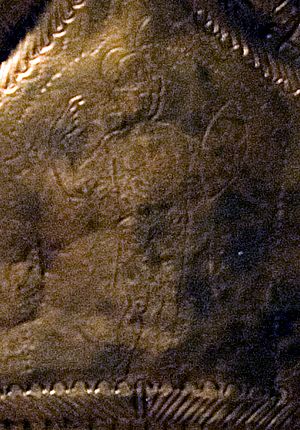Guisborough Helmet facts for kids
Quick facts for kids Guisborough Helmet |
|
|---|---|

The Guisborough Helmet
|
|
| Material | Bronze (copper alloy) |
| Size | 240 millimetres (9.4 in) high |
| Created | 3rd century AD |
| Period/culture | Roman Empire |
| Discovered | By workers employed by the Cleveland Railway Company in 1864 |
| Place | Guisborough, North Yorkshire |
| Present location | Room 49, British Museum, London |
| Identification | P&EE 1878 9-10 1 |
| Registration | 1878,0910.1 |
The Guisborough Helmet is a special Roman helmet made of bronze. It was found in 1864 near Guisborough, England. This helmet was worn by Roman cavalry, who were soldiers who fought on horseback.
The helmet used to have pieces that protected the cheeks, but these are now missing. You can still see the holes where they were attached. This helmet is very fancy, with many detailed pictures carved and pressed into it. This suggests it was probably used for parades or special horse-riding games called tournaments. However, it might have also been worn in battles.
The helmet was found carefully buried in gravel, far from any known Roman sites. After it was found during road construction, it was given to the British Museum in London. There, it was fixed up and is now on display for everyone to see.
Contents
What Does the Helmet Look Like?
This amazing helmet was made from bronze (a mix of copper and other metals) around the 3rd century AD. The band across the front of the helmet has carvings and raised pictures of small shrines. Inside these shrines are gods and goddesses linked to war: Victory, Mars, and Minerva.
Between these figures, you can see pictures of horses and riders. The brow band has three points, like a crown. These points are decorated with twisting snakes whose heads meet in the middle, forming an arch over the god Mars. At the back of the helmet, there are two round bumps shaped like flowers. The sides and top of the helmet have patterns that look like feathers.
A Mysterious Roman Find
The Guisborough Helmet is still a bit of a mystery. It was found folded up and buried by itself, with no other Roman objects nearby. It was also far from any known Roman forts or towns. We don't know why or how it ended up being buried there.
Some historians think that Roman soldiers might have taken items like this home after their service. They might have then buried them as a special offering or to hide them. Another Roman cavalry helmet, called the Crosby Garrett Helmet, was found in a similar way in 2010. It was also folded and buried away from settlements. This suggests it might have been an offering or hidden treasure.
Even though the helmet is thin and very decorated, experts believe helmets like this were used in real battles. They were also used in special cavalry shows called hippika gymnasia.
How the Helmet Was Found
The helmet was discovered on August 19, 1864, at Barnaby Grange Farm. This spot is about two miles west of Guisborough town. Workers found it deep in a bed of gravel while building a road for the Cleveland Railway Company.
A writer named John Christopher Atkinson described the discovery in a magazine in 1864. He said that workers found many animal bones first. Then, they found a folded and bent metal plate that was carved and decorated.
No other old objects were found with the helmet. The animal bones seemed to be from a natural stream that had been there long ago. Atkinson noted that the helmet was in surprisingly good condition, even though it was very old and had been bent.
He wrote that the helmet was "as bright as on the day it was consigned to its place of concealment." This means it looked almost new, except for being folded and where a worker's pickaxe hit it. He believed it was "deliberately buried in a hole dug for the purpose."
Because it was crushed, people didn't know it was a helmet at first. But its beautiful decorations were clear to see. Atkinson described the outer designs, especially two snakes with their heads meeting. He also saw raised bumps and figures that looked like Greek soldiers.
At first, people thought it was a breastplate (chest armor) from an unknown time or place. A local historian even thought it was from a much later period.
Restoration and Display
In 1878, Frederick B. Greenwood, who owned the land where the helmet was found, gave it to the British Museum. Experts at the museum, especially Robert Cooper Ready, carefully restored it. During this process, they discovered it was actually a Roman helmet!
Today, the Guisborough Helmet is on display in Room 49 of the British Museum, in the Roman Britain section. Similar helmets have been found in other parts of Europe. One very similar helmet was found in a river in France. The Guisborough Helmet is so unique that it has given its name to a special type of cavalry helmet, known as the "Guisborough type." These helmets can be recognized by the three peaked scallops on their brow band.
See also



